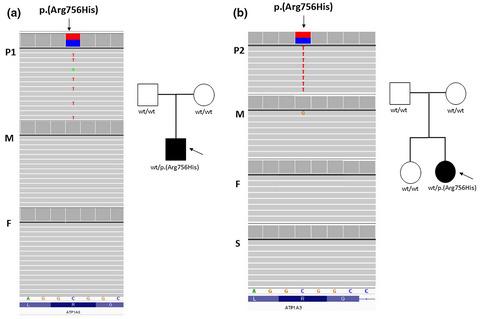当前位置:
X-MOL 学术
›
Mol. Genet. Genomic Med.
›
论文详情
Our official English website, www.x-mol.net, welcomes your
feedback! (Note: you will need to create a separate account there.)
Variants of ATP1A3 in residue 756 cause a separate phenotype of relapsing encephalopathy with cerebellar ataxia (RECA)—Report of two cases and literature review
Molecular Genetics & Genomic Medicine ( IF 1.5 ) Pub Date : 2021-08-02 , DOI: 10.1002/mgg3.1772 Mateusz Biela 1 , Malgorzata Rydzanicz 2 , Krystyna Szymanska 3 , Karolina Pieniawska-Smiech 4 , Aleksandra Lewandowicz-Uszynska 5 , Joanna Chruszcz 6 , Lucyna Benben 7 , Malgorzata Kuzior-Plawiak 7 , Pawel Szyld 8 , Aleksandra Jakubiak 1 , Leszek Szenborn 6 , Rafal Ploski 2 , Robert Smigiel 1
Molecular Genetics & Genomic Medicine ( IF 1.5 ) Pub Date : 2021-08-02 , DOI: 10.1002/mgg3.1772 Mateusz Biela 1 , Malgorzata Rydzanicz 2 , Krystyna Szymanska 3 , Karolina Pieniawska-Smiech 4 , Aleksandra Lewandowicz-Uszynska 5 , Joanna Chruszcz 6 , Lucyna Benben 7 , Malgorzata Kuzior-Plawiak 7 , Pawel Szyld 8 , Aleksandra Jakubiak 1 , Leszek Szenborn 6 , Rafal Ploski 2 , Robert Smigiel 1
Affiliation

|
Variants in ATP1A3 cause well-known phenotypes—alternating hemiplegia of childhood (AHC), rapid-onset dystonia-parkinsonism (RDP), cerebellar ataxia, areflexia, pes cavus, optic atrophy, sensorineural hearing loss (CAPOS), and severe early infantile epileptic encephalopathy. Recently, there has been growing evidence for genotype–phenotype correlations in the ATP1A3 variants, and a separate phenotype associated with variants in residue 756—two acronyms are proposed for the moment—FIPWE (fever-induced paroxysmal weakness and encephalopathy) and RECA (relapsing encephalopathy with cerebellar ataxia).
中文翻译:

756位残基ATP1A3变异引起复发性脑病伴小脑性共济失调(RECA)的不同表型——附2例报告并文献复习
ATP1A3的变异引起众所周知的表型——儿童交替性偏瘫 (AHC)、快速发作的肌张力障碍-帕金森综合征 (RDP)、小脑共济失调、反射消失、高弓足、视神经萎缩、感觉神经性听力损失 (CAPOS) 和严重的早期婴儿癫痫脑病。最近,越来越多的证据表明ATP1A3变体中的基因型 - 表型相关性,并且与残基 756 中的变体相关的单独表型 - 目前提出了两个首字母缩写词 - FIPWE(发烧诱导的阵发性无力和脑病)和 RECA(复发脑病伴小脑性共济失调)。
更新日期:2021-09-23
中文翻译:

756位残基ATP1A3变异引起复发性脑病伴小脑性共济失调(RECA)的不同表型——附2例报告并文献复习
ATP1A3的变异引起众所周知的表型——儿童交替性偏瘫 (AHC)、快速发作的肌张力障碍-帕金森综合征 (RDP)、小脑共济失调、反射消失、高弓足、视神经萎缩、感觉神经性听力损失 (CAPOS) 和严重的早期婴儿癫痫脑病。最近,越来越多的证据表明ATP1A3变体中的基因型 - 表型相关性,并且与残基 756 中的变体相关的单独表型 - 目前提出了两个首字母缩写词 - FIPWE(发烧诱导的阵发性无力和脑病)和 RECA(复发脑病伴小脑性共济失调)。











































 京公网安备 11010802027423号
京公网安备 11010802027423号